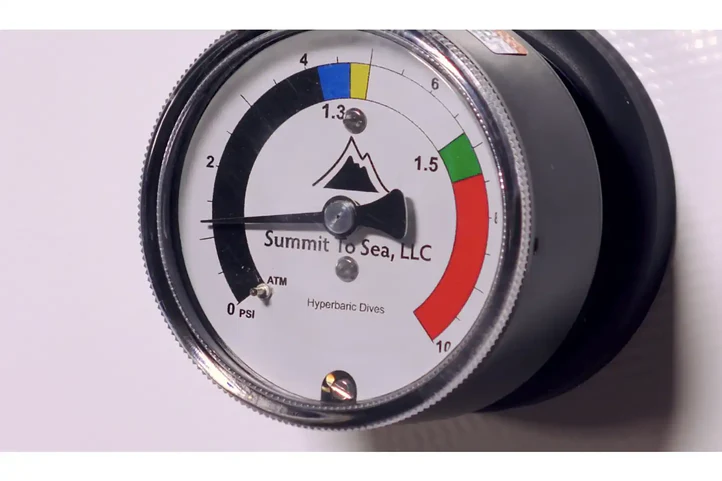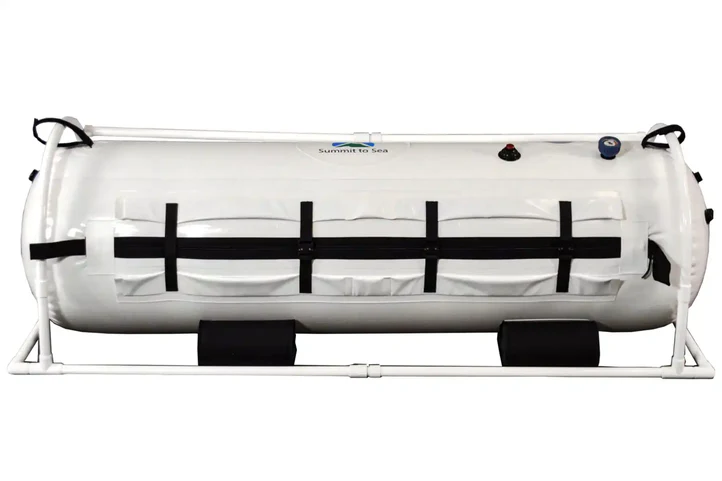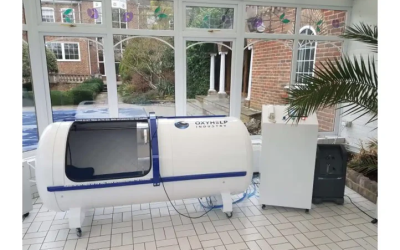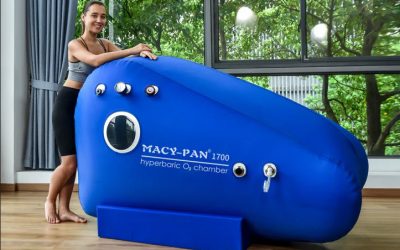Potential Side Effects
- Ear and Sinus Barotrauma: When you’re inside a hyperbaric chamber such as summit to sea hyperbaric chamber, the pressure increases, sometimes leading to discomfort in your ears and sinuses. This sensation is similar to what you may experience when flying or driving through mountains. To alleviate this, your healthcare provider may teach you some techniques to equalize the pressure in your ears, such as swallowing or yawning.
- Oxygen Toxicity: While oxygen is essential for life, breathing pure oxygen for extended periods can have some adverse effects. High oxygen levels may cause seizures, breathing difficulties, or lung damage. However, it’s crucial to remember that these side effects are relatively rare and usually occur only when a person undergoes intensive or prolonged hyperbaric oxygen therapy.
- Claustrophobia: Hyperbaric chambers can be intimidating for some people, especially if you struggle with claustrophobia. Being in an enclosed space for a prolonged period may induce feelings of anxiety or panic. If you have concerns about this, discussing them with your healthcare provider before starting the treatment is important.
- Fire Hazard: Hyperbaric chambers are designed to be safe, but there is a small fire risk inside the chamber. This risk is minimized by ensuring that no flammable substances, such as alcohol-based hand sanitizers or petroleum-based ointments, are present during the treatment.

Barotrauma
Barotrauma occurs when there is a sudden change in pressure, resulting in damage to certain areas of the body. Different types of barotrauma can manifest in various ways. One common form is dental barotrauma, when pressure changes affect your teeth and oral cavity. This can be quite uncomfortable and may even cause pain.
Another type of barotrauma that people may experience is ear barotrauma. This occurs when there is a pressure difference between the inside and outside of your ears. You might feel a sensation akin to being on an airplane during takeoff or landing. The pressure changes can cause discomfort, pain, and even damage your ears.
Pulmonary barotrauma is another potential risk related to barotrauma. It affects your lungs and can lead to serious complications like lung rupture. This is something you want to avoid!
To prevent dental barotrauma, seeing a dentist before undergoing any hyperbaric chamber treatment is advisable. They can assess your oral health and provide necessary measures to minimize the risk of damage. Individuals with sensitivity to pressure changes may require ear tubes to equalize the pressure in their ears during hyperbaric sessions.
Oxygen Toxicity
When we talk about pulmonary oxygen toxicity, we’re referring to the harmful effects of prolonged exposure to high levels of oxygen on your lungs. This condition occurs in two distinct phases: the acute exudative phase and the subacute proliferative phase.
During the acute exudative phase, your lungs may experience interstitial and alveolar edema, which essentially means fluid accumulation in the small air sacs of your lungs. Additionally, you may encounter intra-alveolar hemorrhage, which is bleeding into the air sacs of your lungs. These changes can compromise the efficient exchange of oxygen and carbon dioxide in your lungs and may affect your breathing.
Moving on to the subacute proliferative phase, you may encounter fibroblastic proliferation. This means the cells responsible for tissue repair and remodeling become overactive, forming scar tissue. As a result, your lungs may become stiff, making it harder for them to expand and contract properly during breathing.
In both phases, the destruction of capillary endothelial cells and type I alveolar epithelial cells may occur. This can further impair your lungs’ ability to perform their important oxygenation function.
It’s important to recognize that prolonged exposure to increased oxygen levels can lead to respiratory failure. This means your lungs may not be able to provide enough oxygen to meet your body’s demands. Hence, understanding the manifestations and phases of pulmonary oxygen toxicity is vital in ensuring respiratory health.
Claustrophobia
Have you ever felt that tightening in your chest, the quickening of your breath, and the overwhelming need to escape a small, enclosed space? If so, you may be one of the many people who experience claustrophobia, an anxiety disorder triggered by confinement. It is a fairly common condition, affecting around 5-7% of the population.
For those seeking hyperbaric oxygen therapy (HBOT), where you are placed in a pressurized chamber to receive oxygen, managing and preventing claustrophobia is crucial. The last thing you want when trying to improve your health is to feel a wave of panic.
Luckily, there are strategies to help cope with this anxiety during HBOT. Before entering the chamber, taking slow, deep breaths and practicing relaxation techniques such as imagining yourself in a calm and spacious environment is important. Discussing your fears with healthcare professionals may also be helpful, as they can provide guidance and support.
Another effective approach involves using hyperbaric chambers made of crystal-clear acrylic. These chambers provide a comforting and spacious atmosphere, reducing confinement anxiety. Their transparent walls allow you to see outside the chamber, which helps to create a sense of openness and alleviates claustrophobic sensations.
Medical Risks
One common side effect of oxygen therapy is a dry or bloody nose. This occurs because the oxygen can cause the nasal passages to become dry or irritated. A humidifier or a saline nasal spray can help moisturize the nasal passages to alleviate this discomfort. Another possible side effect is tiredness. Oxygen therapy can sometimes make people feel tired or sleepy. If you experience this, it’s crucial to rest and allow your body to adjust to the treatment.
Morning headaches may also occur as a side effect of oxygen therapy. These headaches are usually mild and can often be relieved by drinking plenty of fluids. However, you must consult your healthcare provider if the headaches persist or worsen.
There are a few important precautions to ensure safety during oxygen therapy. First and foremost, smoking or using flammable materials near oxygen is extremely hazardous due to the increased fire risk. Keeping oxygen tanks away from open flames or heat sources is vital. Oxygen tanks must always be secured and kept upright to prevent potential hazards.
Practical Considerations
Types of Chambers: Two main hyperbaric chambers are monoplane and multiple. Monoplace chambers are designed for single-person use, while numerous chambers can accommodate numerous people simultaneously. The choice between the two depends on your specific needs and the type of therapy being administered. Monoplace chambers are generally more common and offer privacy, while multiple chambers allow for collaboration or support from others during treatment.
Safety and Comfort: Hyperbaric chamber sessions are generally safe, but certain safety measures must be implemented. Chambers should be well-maintained and regularly inspected to ensure efficiency and safety. Comfort is also a key consideration, as sessions can last anywhere from 60 to 90 minutes. Most chambers are equipped with comfortable seating, lighting, and entertainment options to help pass the time while undergoing treatment.
Operating Procedures: Hyperbaric chambers increase the air pressure, creating an environment with higher oxygen levels than what we typically breathe. Before entering the chamber, you’ll need to remove any metal objects that can become hazardous due to pressure changes. You may also be required to wear specific clothing or a gown that is provided. Once inside the chamber, trained professionals will closely monitor you throughout the session to ensure your safety and comfort.
Potential Benefits and Risks: Hyperbaric chambers primarily treat conditions that benefit from increased oxygen levels, such as decompression sickness, non-healing wounds, and certain infections. The therapy can also provide relief for certain conditions like autism, multiple sclerosis, and traumatic brain injuries. However, it’s crucial to consult with your healthcare provider before considering hyperbaric therapy, as there are also potential risks and contraindications to be aware of.
Time Commitment
Using a hyperbaric chamber typically involves multiple sessions, each lasting around 60 to 120 minutes. The number of sessions required varies depending on the specific condition being treated and the individual’s response to the therapy. Generally, people may need anywhere from 20 to 40 sessions spread over several weeks.
One of the main challenges related to the time commitment is finding a balance between attending these sessions and managing other daily responsibilities. Depending on your schedule, fitting in these sessions might require planning and coordination. It’s important to prioritize your health and communicate with your healthcare provider to find a schedule that works for you.
Moreover, while each session lasts 60 to 120 minutes, the time spent inside the hyperbaric chamber is lower due to the time needed for pressurization and decompression. These initial and final phases can take 10 to 15 minutes each.

Limited Effectiveness
Firstly, it’s important to know that hyperbaric chambers have limitations. While they can be helpful in certain medical conditions, they are not a cure-all solution. For instance, research has shown that hyperbaric oxygen therapy may benefit people with carbon monoxide poisoning or certain types of wounds. Still, its effectiveness in other areas could be improved.
One of the main limitations of hyperbaric chambers is that they may not significantly benefit people with chronic conditions or diseases. Take Parkinson’s disease, for example. While some studies have explored the use of hyperbaric chambers for Parkinson’s patients, the results have been inconclusive. The therapy may not substantially impact their symptoms or overall well-being.
The limited effectiveness of hyperbaric chambers can also be seen in the treatment of autism. Some individuals believe that hyperbaric oxygen therapy can help improve the symptoms of autism, but there is not enough scientific evidence to support this claim. Research has been inconsistent, and the impact of hyperbaric chambers on autism remains uncertain.
Limited Effectiveness
Firstly, let’s discuss the low success rate. Studies have shown that hyperbaric chambers have mixed results when providing tangible benefits. For instance, in a recent research study, only 30% of patients reported significant improvements. That’s a less-than-favorable outcome.
Secondly, the lack of measurable impact is a cause for concern. Many medical experts argue that the benefits observed from hyperbaric chambers are often subjective and challenging to quantify. Determining if the treatment truly positively affects people’s health.
Becomes challenging. Moreover, the minimal long-term results add another dimension to this limited effectiveness. While hyperbaric chamber treatments may temporarily relieve certain conditions, the long-term effects are often inconclusive. Considering the long-term benefits before placing your hopes on this treatment is crucial.
But what factors contribute to this limited effectiveness? Well, resource constraints play a significant role. Many medical facilities need more resources to invest in state-of-the-art hyperbaric chamber equipment, hindering its efficacy. Additionally, adequate training and consistent implementation of treatment protocols may also impact the overall outcome.




